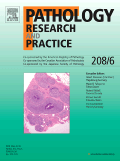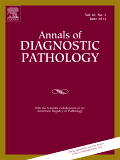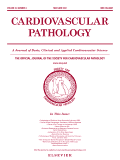
PATHOLOGY RESEARCH AND PRACTICE
Scope & Guideline
Fostering Collaboration in Pathological Research
Introduction
Aims and Scopes
- Molecular Pathology:
Research exploring the molecular mechanisms underlying diseases, including cancer genomics, epigenetics, and the role of non-coding RNAs in tumor progression. - Histopathological Studies:
Detailed examinations of tissue specimens to identify disease patterns, tumor characteristics, and their correlation with clinical outcomes. - Diagnostic Innovations:
Development and validation of novel biomarkers and diagnostic techniques, including immunohistochemical markers and next-generation sequencing applications. - Cancer Immunology:
Studies focused on the tumor microenvironment, immune evasion mechanisms, and the role of immune checkpoints in cancer progression and therapy. - Therapeutic Research:
Research on therapeutic targets, including drug resistance mechanisms, and the potential of novel treatment modalities such as immunotherapy and gene therapy.
Trending and Emerging
- Role of Non-coding RNAs:
Increasing research on non-coding RNAs, particularly their roles in cancer progression, chemoresistance, and as potential therapeutic targets, showcases the expanding understanding of RNA biology in pathology. - Tumor Microenvironment Studies:
A growing emphasis on the tumor microenvironment, including interactions between cancer cells and stromal components, is evident, highlighting its significance in cancer biology and treatment responses. - Artificial Intelligence and Digital Pathology:
The integration of artificial intelligence and machine learning techniques in pathology for diagnostic purposes is a rapidly emerging theme, showcasing the potential for enhanced accuracy and efficiency in diagnostics. - Immunotherapy and Cancer Treatment:
Research focusing on immunotherapeutic strategies, including the exploration of immune checkpoint inhibitors and their roles in various cancers, is gaining momentum, reflecting a significant shift in cancer treatment paradigms. - Personalized Medicine Approaches:
Emerging studies on personalized medicine in pathology, particularly the use of genetic and epigenetic profiling to tailor treatments, are becoming increasingly prevalent.
Declining or Waning
- Traditional Histopathology Techniques:
There has been a noticeable decrease in studies emphasizing traditional histopathological techniques without molecular or genetic components, as the field moves towards more integrative approaches that combine histology with molecular data. - Single Disease Focus:
Research centered exclusively on individual diseases without consideration of broader implications or multi-disease comparisons is becoming less common, as interdisciplinary studies gain traction. - Basic Pathophysiology Studies:
Papers focusing solely on basic pathophysiological mechanisms without direct clinical or therapeutic relevance are less frequently published, indicating a trend towards translational research.
Similar Journals

ENDOCRINE PATHOLOGY
Advancing the Future of Endocrine ResearchENDOCRINE PATHOLOGY is a premier journal published by HUMANA PRESS INC, dedicated to advancing the understanding of endocrine disorders through innovative research and clinical practices. With an impressive impact factor and consistently ranked in the Q1 quartile across multiple categories such as Endocrinology, Diabetes and Metabolism, as well as Pathology and Forensic Medicine, this journal serves as a pivotal resource for researchers and professionals in the field. The journal covers a broad spectrum of topics related to endocrine pathology, providing insights into mechanisms, diagnostics, and therapeutics that inform both clinical and laboratory practices. Although it does not offer open access, its rigorous peer-review process ensures the dissemination of high-quality, impactful research that shapes clinical strategies and enhances patient care. With distribution spanning from its inception in 1990 to 2024, ENDOCRINE PATHOLOGY stands at the forefront of endocrine research, making it an essential read for anyone involved in the study and treatment of endocrine disorders.

HISTOLOGY AND HISTOPATHOLOGY
Advancing the Frontiers of Tissue ScienceHISTOLOGY AND HISTOPATHOLOGY, published by F HERNANDEZ, is an esteemed academic journal dedicated to advancing the fields of histology and pathology. With its ISSN 0213-3911 and E-ISSN 1699-5848, this journal has been a crucial resource for researchers and professionals since its inception in 1986. The journal enjoys a strong reputation, evidenced by its Q2 category rankings in both Histology and Pathology & Forensic Medicine as of 2023, positioning it within the top tier of scholarly publications. With Scopus rankings placing it at Rank #74/208 in Medicine - Pathology and Forensic Medicine and Rank #31/62 in Medicine - Histology, it proves to be an essential platform for disseminating significant research findings and innovations. Although the journal is not open access, it is committed to providing high-quality, peer-reviewed articles that cater to the needs of its academic community. With a focus on fostering a deeper understanding of tissue structure and disease mechanisms, HISTOLOGY AND HISTOPATHOLOGY serves as an indispensable resource for students, researchers, and practitioners alike, facilitating the exchange of knowledge and pioneering research in these vital areas of study.

Annals of Diagnostic Pathology
Transforming Medical Science with Diagnostic Innovations.Annals of Diagnostic Pathology, published by Elsevier Science Inc, is a pivotal journal in the field of diagnostic pathology that has significantly contributed to the advancement of medical science since its inception in 1997. With an ISSN of 1092-9134 and E-ISSN of 1532-8198, this esteemed journal is positioned within the Q2 category in both Medicine (miscellaneous) and Pathology and Forensic Medicine, reflecting its high-quality research contributions, showcased by its ranking at #73 out of 208 in Scopus for the latter category. The journal's scope encompasses various aspects of diagnostic pathology, from innovative techniques to critical reviews of pathologic findings, making it an essential resource for researchers, medical professionals, and students dedicated to enhancing diagnostic accuracy and patient care. Although it does not currently offer open access options, its wide readership and impactful publications continue to influence clinical practices and research agendas. With a convergence period extending to 2024, Annals of Diagnostic Pathology remains a leading platform for disseminating valuable knowledge in this dynamic field.

INTERNATIONAL JOURNAL OF EXPERIMENTAL PATHOLOGY
Shaping the Future of Experimental PathologyINTERNATIONAL JOURNAL OF EXPERIMENTAL PATHOLOGY, published by Wiley, is a leading peer-reviewed journal dedicated to the field of experimental pathology. With an ISSN of 0959-9673 and E-ISSN 1365-2613, the journal has been a vital resource for researchers and professionals since its inception in 1990, covering a broad spectrum of topics within pathology, cell biology, and molecular biology. The journal's relevancy is underscored by its Q2 ranking in Pathology and Forensic Medicine and Q3 rankings in both Cell Biology and Molecular Biology, as of 2023, reflecting its significant contribution to the scientific community. Although it does not currently offer open access options, readers can benefit from its insightful research articles and reviews that guide advancements in diagnostic pathology and therapeutic strategies. As the journal continues to evolve, it remains committed to facilitating the exchange of innovative ideas and findings that drive progress in experimental pathology and related fields, making it an indispensable platform for scientists, clinicians, and students alike.

JOURNAL OF GENE MEDICINE
Exploring the Future of Genetic InnovationThe Journal of Gene Medicine, published by Wiley, stands as a pivotal resource in the field of gene therapy and molecular medicine, with a rich history of dissemination of impactful research since its inception in 1998. With an ISSN of 1099-498X and an E-ISSN of 1521-2254, this esteemed journal plays a crucial role in advancing our understanding of genetics and drug discovery, reflected in its impressive 2023 Scopus rankings where it holds a Q2 classification in Drug Discovery and Q3 in several genetics-related categories. The journal aims to facilitate the exchange of high-quality research findings that bridge the gap between laboratory and clinical applications, making it an essential platform for researchers, academics, and healthcare professionals committed to the forefront of genetic innovation. Although it does not currently offer open access options, its reputation for rigorous peer review ensures that all published work meets the highest academic standards, providing a reliable reference for scientific inquiry in the United States and beyond. As the field rapidly evolves, the Journal of Gene Medicine remains at the helm, guiding future discoveries with its influential publications and comprehensive insights.

AJSP-Reviews and Reports
Connecting Researchers and Professionals in Forensic ScienceAJSP-Reviews and Reports is a peer-reviewed journal dedicated to the advancement of knowledge within the field of pathology and forensic medicine. Published by the renowned Lippincott Williams & Wilkins, this journal plays a vital role in disseminating insightful reviews and reports that contribute to the understanding and application of diagnostic practices and forensic investigations. While currently listed in the fourth quartile (Q4) within its category according to the 2023 metrics, the journal is committed to enhancing its impact and fostering scholarly dialogue among researchers, professionals, and students in the medical community. Despite challenges in Scopus rankings, it provides a platform for significant discourse and innovation in pathology. Operating from the United Kingdom, AJSP-Reviews and Reports is positioned to bridge gaps in knowledge and inspire future research developments. Readers can access valuable findings without open access barriers, allowing for efficient information sharing within the medical field.

NAR Cancer
Empowering discovery in the fight against cancer.NAR Cancer, published by Oxford University Press, is a pioneering open access journal established to advance the rapidly evolving field of cancer research. Since its inception in 2019, this journal has gained substantial recognition, achieving a prestigious Q1 ranking in both Cancer Research and Oncology categories as of 2023. With a focused objective to disseminate high-quality research, reviews, and insights into innovative cancer treatments and diagnostics, NAR Cancer serves as an essential platform for researchers, healthcare professionals, and students alike. The journal is accessible for all since it became open access in 2020, ensuring a global reach and impact. Positioned in the competitive landscape of oncology, with impressive Scopus rankings, it offers a unique opportunity for contributors to share their work with an engaged and interdisciplinary audience. With a commitment to excellence, NAR Cancer is dedicated to driving forward the understanding and management of cancer worldwide.

JOURNAL OF COMPARATIVE PATHOLOGY
Bridging Disciplines in Pathology and Forensic MedicineJOURNAL OF COMPARATIVE PATHOLOGY, published by Elsevier Science Ltd, stands as a significant publication within the fields of pathology and forensic medicine, as well as veterinary studies. With an ISSN of 0021-9975 and an E-ISSN of 1532-3129, this journal has been disseminating critical research since 1950, contributing to the advancement of knowledge through its focus on comparative pathology. The journal's reputable standing is underscored by its Q3 classification in Pathology and Forensic Medicine and Q2 in Veterinary (miscellaneous) for 2023, reflecting its vital role in shaping contemporary discourse in these domains. The Scopus ranks further solidify its presence, placing it at the 51st percentile in general veterinary sciences and the 32nd percentile in pathology—a testament to the quality and relevance of the contributions it publishes. Although it operates under a subscription model, the journal remains accessible to researchers and practitioners who aim to deepen their understanding of pathological phenomena across species, enhance diagnostic accuracy, and improve clinical practices. With a steadfast commitment to rigorous peer review and a global readership, the JOURNAL OF COMPARATIVE PATHOLOGY is an essential resource for those engaged in research and professional practice, fostering collaborations and innovations that bridge complementary areas of study.

GENE
Unveiling Innovations in Genetics and MedicineGENE, an esteemed journal published by Elsevier, serves as a vital resource for researchers and professionals in the fields of genetics and medicine. With an ISSN of 0378-1119 and an E-ISSN of 1879-0038, this scholarly journal has been at the forefront of genetic research since its inception in 1976 and is set to continue until 2025. Situated in the Netherlands, GENE is recognized for its significant contributions, reflected in its Q2 ranking in both Genetics and Miscellaneous Medicine categories for 2023. This positioning within the Scopus rankings demonstrates its impact and relevance in a competitive field, where it holds the rank of #129 out of 347 in Genetics, placing it within the 62nd percentile. Although it does not offer open access options, GENE provides invaluable insight into contemporary genetic research, thereby fostering academic discussions and advancements. Researchers, professionals, and students alike will find GENE an essential platform for disseminating knowledge and exploring innovative developments in genetics and associated sciences.

CARDIOVASCULAR PATHOLOGY
Transforming understanding through rigorous research.CARDIOVASCULAR PATHOLOGY, published by Elsevier Science Inc, is a distinguished journal dedicated to the dissemination of high-quality research in the fields of cardiology, pathology, and cardiovascular medicine. With an ISSN of 1054-8807 and an E-ISSN of 1879-1336, this journal has established itself as a vital resource for researchers, clinicians, and students alike. It is positioned in the Q2 quartile for both cardiology and pathology, indicating its significant impact and relevance in these disciplines. The journal offers a platform for innovative studies, reviews, and clinical insights, aiming to enhance our understanding of cardiovascular conditions and their pathological underpinnings. With an H-index that showcases its scholarly influence, CARDIOVASCULAR PATHOLOGY is committed to advancing the field through rigorous peer review and open dialogue among professionals. The journal is accessible through institutional subscriptions, making it an essential reference point for ongoing research through its convergence of knowledge from 1992 through 2024.